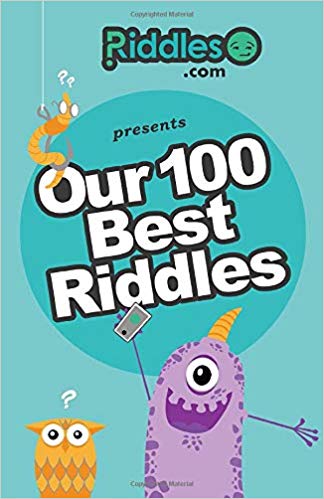
Riddle:
It has rib bones and back bones. It swallows human beings whole, then spits them out alive. What is it?
Answer: A house.
Riddle:
Dreaming of apples on a wall. And dreaming often, dear. I dreamed that, if I counted all, How many would appear?
How many?
Answer: And dreaming of ten, dear.
Riddle:
Suppose you want to send in the mail a valuable object to a friend. You have a box which is big enough to hold the object. The box has a locking ring which is large enough to have a lock attached and you have several locks with keys. However, your friend does not have the key to any lock that you have. You cannot send the key in an unlocked box since it may be stolen or copied. How do you send the valuable object, locked, to your friend - so it may be opened by your friend?
Answer: Send the box with a lock attached and locked. Your friend attaches his or her own lock and sends the box back to you. You remove your lock and send it back to your friend. Your friend may then remove the lock she or he put on and open the box.
Riddle:
A sign on the barber's door says "I shave only those who do not shave themselves". Does the barber shave himself?
Answer: There is no answer; it's a paradox. It cannot be made to work.
Riddle:
If seven cats kill seven rats in 7 minutes, how many would be needed to kill one hundred rats in 50 minutes?
Answer: 14.
Riddle:
How can you spell "enemy" in three letters?
Answer: F O E.
Riddle:
Can you list 15 items that are sold in pairs?
Answer: 1. Shoes
2. Gloves
3. Socks
4. Ice Skates
5. Skis
6. Shoe laces
7. Earrings
8. Ear plugs
9. Dice
10. Reese's Peanut Butter Cups Candy
11. Speakers
12. Dumb Bells
13. Chop sticks
13. Drum sticks
14. Knee pads
15. Fake eyelashes
Riddle:
A dog had three puppies, named Mopsy, Topsy and Spot. What was the mothers name?
Answer: What
Riddle:
A man walking along a railraod track sees a train thundering at high speed towards him. Instead of immediately jumpimg off the track, he charges directly at the train for about ten feet and only then gets off the track.
Why?
Answer: The man was on a bridge when he first saw the train so he couldn't jump off the track immediately.
Riddle:
A horse travels a certain distance each day. Strangely enough, two of its legs travel 30 miles each day and the other two legs travel nearly 31 miles. It would seem that two of the horse's legs must be one mile ahead of the other two legs, but of course, this can't be true, since the horse is normal. How is this possible?
Answer: The horse operates a mill and travels in a circular clockwise direction. The two outside legs will travel a greater distance than the two inside legs.
Riddle:
Holding two long poles, five fellows chase a herd of white buffalo into a cave. What is really going on here?
Answer: They're eating rice with a pair of chopsticks.
Riddle:
A book costs $1 plus half its price. How much does it cost?
Answer: $2
Riddle:
What is the difference between a dollar and a half and thirty five-cents?
Answer: Nothing. A dollar and a half is the same as thirty five-cents (nickels). But not the same as thirty-five cents.
Riddle:
As a whole, I am both safe and secure. Behead me, and I become a place of meeting. Behead me again, and I am the partner of ready. Restore me, and I become the domain of beasts.
What am I?
Answer: Stable.
Riddle:
I can come in a can,
I can come as a punch,
I can come as a win,
You can eat me for lunch.
What am I?
Answer: Beet/Beat
Riddle:
How can you hold a piece of string, one end in each hand, and tie a knot in the string with out letting go of either end?
Answer: Cross your arms before you seize the ends of the string. Uncross your arms and it will tie a knot!
Riddle:
Of no use to one Yet absolute bliss to two. The small boy gets it for nothing. The young man has to lie for it. The old man has to buy it. The baby's right, The lover's privilege, The hypocrite's mask. To the young girl, faith; To the married woman, hope; To the old maid, charity. What am I?
Answer: A Kiss.
Riddle:
What word starting with BR, that with the addition of the letter E, becomes another word that sounds the same as the first?
Answer: Braking becomes Breaking.
Riddle:
Our dinner guests cry that we are evil, when they notice their place in the meal. But its no big deal why; we are just one big happy tribe! And we get reall fed up with people!
Who, What or Are we?
Answer: Cannibals!
Riddle:
Julie is going on an extended trip for three weeks. She lives in a remote area where there are frequent electrical power outages which can last up to three or four days. Julie has quite a bit of food in her freezer which would go bad if it thawed and then re-froze. She does have digital clock and a VCR which would flash 12:00 if the power went out. Unfortunately the clock and VCR flash even if the power only goes out for a few seconds. What can Julie do so that when she returns home she will be able to determine whether the power was out long enough to thaw her food? Asking a neighbor whether the power was out, isn't a reliable option because the nearest house is half a mile away, and one house may have power, while another house may have no power. She won?t be able to have a neighbor check on her house every day, and has no one to house sit.
Answer: One thing Julie could do is freeze a tray of ice-cubes, and turn the tray of ice upside down in her freezer. When she comes home, she should check the tray. If the ice cubes are still in the tray, the food is safe to eat. If the trays are empty, it's time to clean out the freezer. She will have to make a judgment call if the ice-cubes are only slightly thawed.

